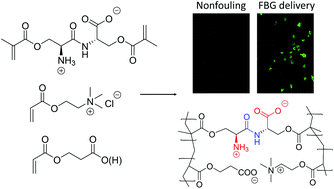Synthesis of a zwitterionic N-Ser–Ser-C dimethacrylate cross-linker and evaluation in polyampholyte hydrogels†
Abstract
Polyampholyte hydrogels are attractive materials for tissue engineering scaffolds as they offer a wide variety of features including nonfouling, selective protein delivery, and tunable physical characteristics. However, to improve the potential performance of these materials for in vivo applications, there is a need for a higher diversity of zwitterionic cross-linker species to replace commonly used ethylene glycol (EG) based chemistries. Towards this end, the synthesis of a dipeptide based zwitterionic cross-linker, N-Ser–Ser-C dimethacrylate (S–S) from N-Boc-L-serine is presented. The strategy utilized a convergent coupling of methacrylated serine partners followed by careful global deprotection to yield the zwitterionic cross-linker with good overall yields. This novel cross-linker was incorporated into a polyampholyte hydrogel and its physical properties and biocompatibility were compared against a polyampholyte hydrogel synthesized with an EG-based cross-linker. The S–S cross-linked hydrogel demonstrated excellent nonfouling performance, while promoting enhanced cellular adhesion to fibrinogen delivered from the hydrogel. Therefore, the results suggest that the S–S cross-linker will demonstrate superior future performance for in vivo applications.



 Please wait while we load your content...
Please wait while we load your content...